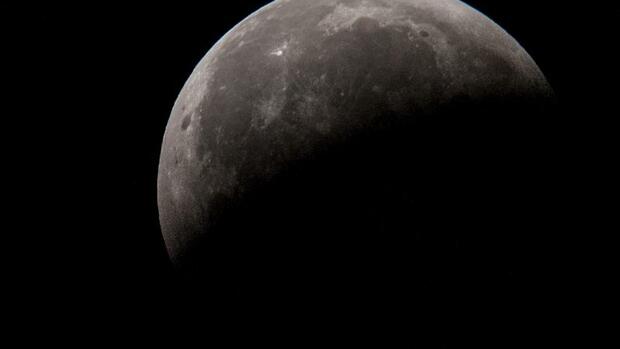After the total eclipse, the moon becomes visible again. The notable astronomical event in May is undoubtedly a total lunar eclipse. Photo: Boris Rossler / D
(Photo: dpa)
In addition, the sky is already bright, since sometimes observers can only follow a partial lunar eclipse, as explained by the head of the Association of Friends of Stars in Germany, Sven Melchert, at the request of the German news agency.
Southeast and Northeast clear of clouds
And the weather can also throw a wrench into the works for the curious. “The situation looks bad in the northwest,” a spokesman for the German Weather Service (DWD) in Offenbach said about the weather forecast early Monday morning. In the southeast and northeast it can be cloud-free, but even that’s not guaranteed yet. There may be cloud gaps in the southwest. However, there are still uncertainties in general, as there are still different weather models and it is still possible for a low level to slip.
In any case, the Earth’s satellite will not completely disappear from the sky with the naked eye. During total and partial lunar eclipses, the moon covered in the Earth’s shadow glows red, sometimes only in pale colors. According to DWD, this is related to deflecting sunlight in the Earth’s atmosphere. According to a representative survey conducted by YouGov Opinion Research Institute, more than a third of people in Germany plan to witness at least the phases of a lunar eclipse.
Today’s Top Jobs
Find the best jobs now and
You are notified by e-mail.
The total phase ends shortly before 7 am
Melchert said the total starts at 5:29 a.m., exactly when Trabant is set, as seen from central Germany. To the east you miss this scene, and in the far west you can observe the total stage for a short time. The middle of the eclipse is reached at 6:12 AM, and the total phase ends just before 7:00 AM.
“A lunar eclipse describes the astronomical process by which the moon moves through shadow space on Earth,” says the DWD website in Offenbach. Such an event occurs only at the full moon and when the Sun, Earth and Moon are in exactly the same line of space. However, it does not happen automatically with every full moon. “The reason for this is that the Moon’s orbit around the Earth is tilted about five degrees compared to the Earth’s orbit around the Sun, where the Earth’s shadow is,” says DWD. Therefore, the full moon usually passes under the earth’s shadow or above it.
Just before 4:30 a.m., the moon enters the Earth’s shadow. However, for many, it will end around 5 am due to sunset, when the moon will enter half of the Earth’s shadow.

“Food practitioner. Bacon guru. Infuriatingly humble zombie enthusiast. Total student.”








More Stories
Kyiv: Russian Kursk offensive halted
US Presidential Election: Former US Government Officials Warn Against Donald Trump's Election
Netherlands wants to leave asylum system